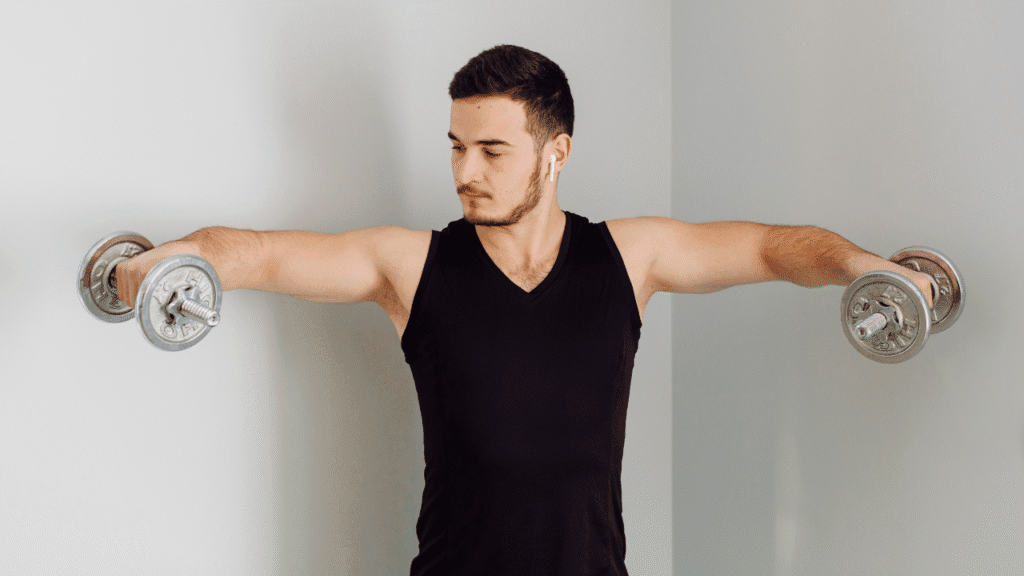How to Dumbbell Lateral Raise for Wider Shoulders

What’s up, legends! Want that broad, powerful V-taper look? Then you need to master the dumbbell lateral raise. This move might look simple, but when done right, it’s a shoulder-widening game-changer. Today, we’re breaking it all down — technique, form, mistakes, and pro tips to unlock those capped delts. Whether you’re lifting in your garage or repping in a gym, this is your go-to guide for making your side delts pop.
1: Why Lateral Raises Matter
Lateral raises target your medial deltoids — the side part of your shoulders. That’s what creates width and adds that powerful silhouette. Presses build mass, but lateral raises sharpen and define. They isolate the side delts more than most compound movements ever will. Want that superhero frame? This is your secret weapon. Lateral raises help you fill out your T-shirts, balance out your upper body, and build the aesthetics that turn heads. If you’ve been skipping these in favor of just overhead pressing — it’s time to fix that. Your shoulder gains are waiting.
2: Choosing the Right Dumbbells
Light weight, big results. This isn’t about ego lifting — it’s about control. Grab dumbbells that let you move slowly and with precision. Start light, even 5–10 lbs, and focus on the burn, not the number. If you’re swinging like crazy, your traps are stealing the spotlight. Remember: it’s not about how heavy you go, it’s about how perfectly you move. Save the heavy lifts for rows and presses. For lateral raises, precision = growth. Start small, build strong.
3: Perfect Starting Position
Stand tall. Feet shoulder-width. Core tight. Dumbbells at your sides with a slight bend in your elbows. Shoulders down and back — no shrugging. You want to feel solid and balanced, like a statue about to take flight. No rocking, no swinging. Engage your abs like you’re about to get punched. This position isn’t just prep — it’s the foundation. Every rep should start with this locked-in stance. The better your setup, the stronger the activation. Start clean, finish strong.
4: Controlled Lifting Technique
Raise the dumbbells out to the sides slowly, like you’re pouring water from a jug. Stop when your arms are parallel to the floor — no need to go higher. Lead with your elbows, not your hands. Think about lifting with your delts, not your wrists. That slight bend in the elbow? Keep it there the whole time. You’re sculpting, not flailing. 2 seconds up, 2 seconds down — that’s your golden tempo. Keep it smooth, keep it steady. The slower you go, the more your delts will scream. And that’s exactly what you want.
5: The Negative is Everything
Everyone focuses on the lift — but the real magic? The lowering phase. That’s where the muscle breaks down and grows. Lower the weights under control — don’t let gravity do the work. Feel that tension pulling through your delts as you return to the start. This part hurts — but that pain? It’s pure progress. Embrace it. Lower with purpose, feel every inch, and resist the urge to drop fast. A slow negative turns average raises into muscle-building machines.
6: Reps, Sets & Frequency
Aim for 3–4 sets of 12–15 reps. This is a hypertrophy move, so volume is key. Focus on muscle connection, not moving max weight. You can train side delts 2–3 times a week, especially if they’re lagging. Just don’t overdo it. Lateral raises pair well with push days or upper body days. Stack them after overhead presses for the ultimate shoulder burnout. And don’t be afraid to use them as a finisher to torch every last fiber. Keep it consistent, and the width will come.
7: Common Mistake #1 – Shrugging Shoulders
You’re trying to grow your delts, not your traps. If your shoulders are creeping up, you’re doing it wrong. Shrugging shifts the tension up and ruins your lateral raise. Keep your traps relaxed and your shoulders down and back. Imagine pinching a pencil between your shoulder blades. That’s the feel. If you’re shrugging, drop the weight and reset your form. Remember: side delts only. Traps already get enough love — let them chill.
8: Common Mistake #2 – Swinging the Weight
Momentum is the enemy. If you’re using your hips, you’re stealing the work from your shoulders. Lateral raises aren’t a dance move. Lock in your core. Stop the swing. Every rep should be strict. Controlled. If the weight is too heavy, scale it down. Focus on the burn, not the bounce. Want results? Drop the ego, tighten your form, and let your shoulders do the talking. Strict reps = wider delts.
9: Advanced Tip – Pause Reps & Partials
Want to take things next level? Add pause reps at the top for 1–2 seconds. That hold is brutal but golden. Or throw in partials after your full reps — tiny raises in the hardest range. These finish off the fibers that full reps miss. Burnout sets like these are delt-sculpting gold. You’ll hate them in the moment, but your shirts will thank you later. Trust the burn. Push past the limit. That’s where the gains live.
10: Best Time to Use Lateral Raises
Slot them in after compound lifts like presses or upright rows. Your delts are already fired up — now isolate and finish strong. You can also use them during warmups with resistance bands to activate your shoulders. Or go crazy and use them as part of a giant set for shoulders. Flexibility is the name of the game. Just make sure they’re in your routine somewhere. They’re not optional — they’re essential.
That’s how you dumbbell lateral raise like a shoulder-building savage. Lock in your form, drop the ego, and chase that burn every single rep. Those capped delts and wide shoulders? They’re built with reps like these. and keep building that beast-mode physique. Peace out, champs!
Men’s trending fashion and how to look attractive. Here teaching fashion, so make sure to check it out.
Men’s Fitness tips, what you eat and how to stay fit your body. The best workout and best diet plan, so make sure to check it out.
Men’s lifestyle tips, how to live a better life, and changing your lifestyle tips, so make sure to check them out.
It cannot be denied that men have finally come to their senses when it comes to good grooming and fashion statement.
Men are also equally frustrated with bad hair days in their life, even though not as annoyed as women. Even though men have short haircuts, they also face problems in maintaining their hair.
There are no formulae for success but there are some successful entrepreneur tips that can help make things a little simpler.









